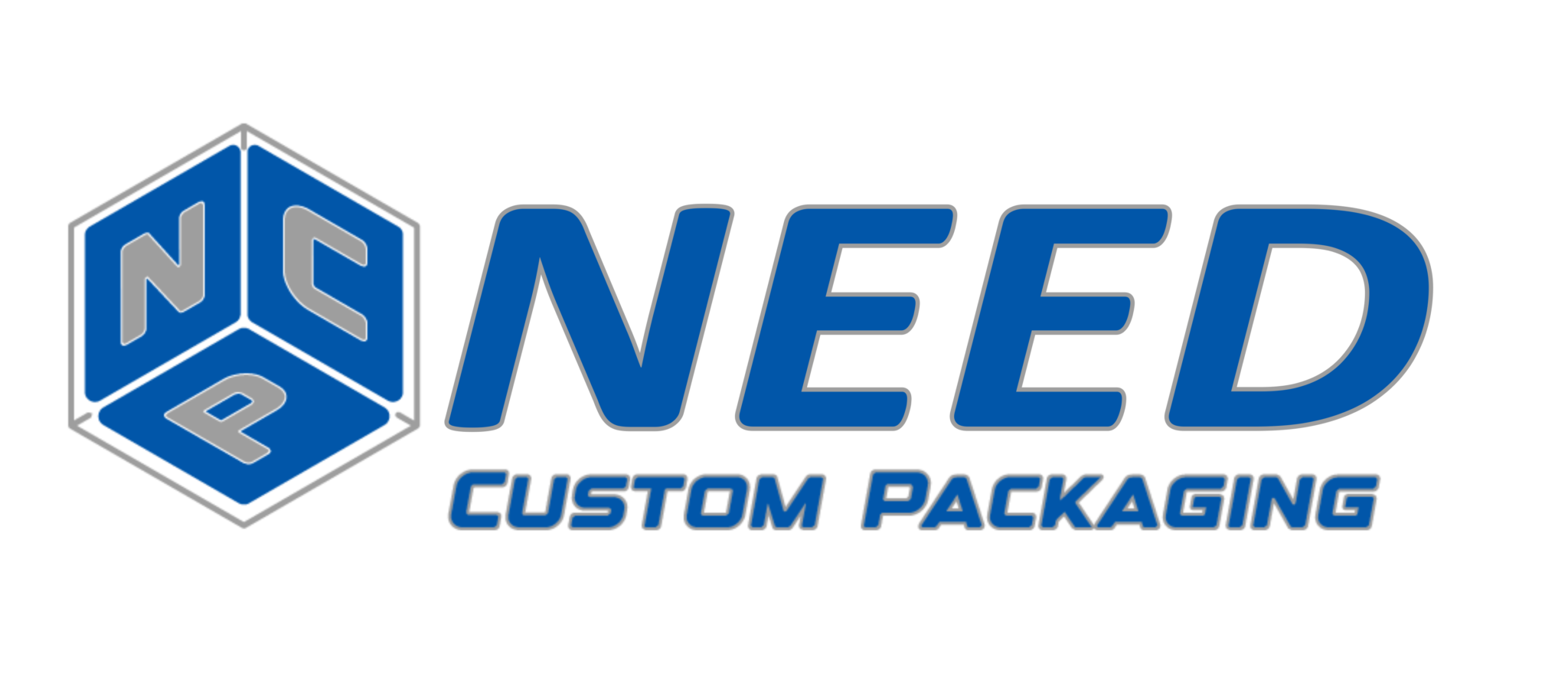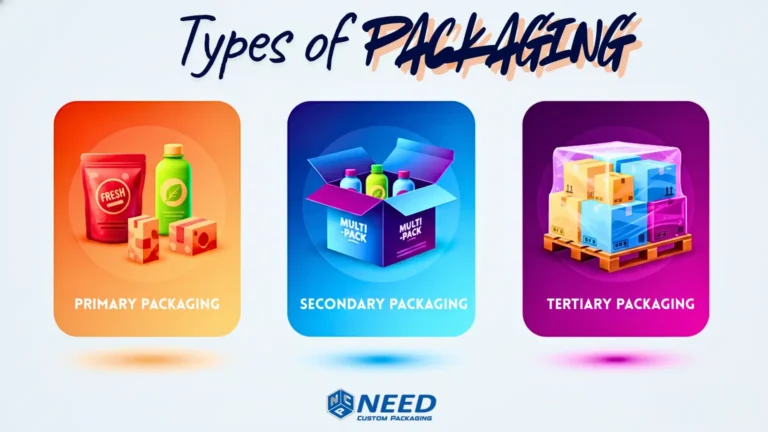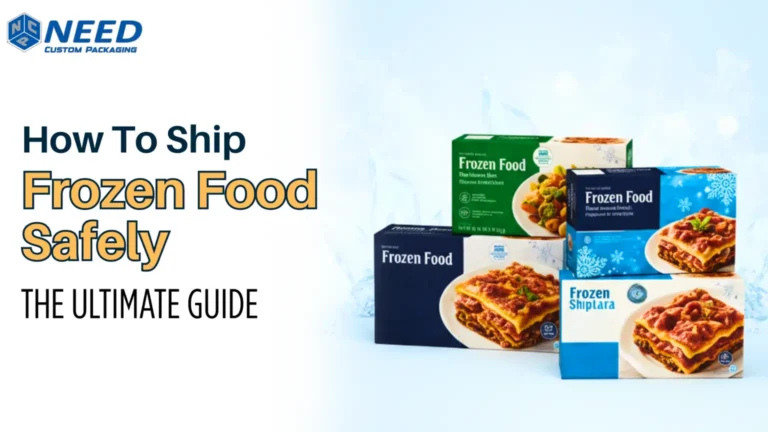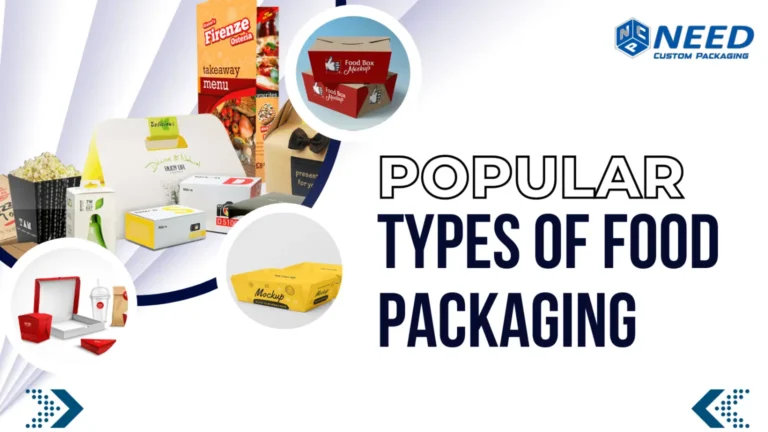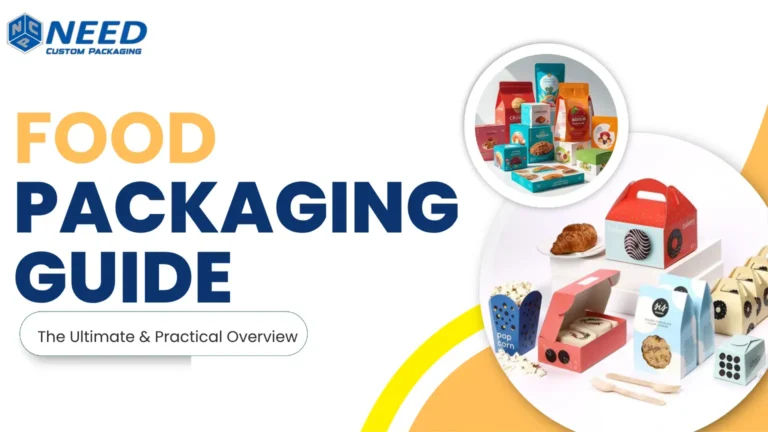Packaging plays a more powerful role than ever, controlling everything from consumer trust to sustainability goals. Today’s consumers want more than good looks; they expect packaging to be eco-friendly, functional, and smart.
For businesses, selecting the correct type of packaging not only determines how well the product is protected but also how it performs on shelves and online.
Whether you’re selling food, cosmetics, electronics, or fashion items, understanding the types of packaging will help you choose the right one for your product and your audience.
If you’re new to the concept and want to understand its fundamentals, check out our complete guide on what packaging is. It explains the purpose, types, and importance of packaging before you explore its materials in detail.
3 Main Types of Packaging
Every product undergoes three main packaging stages: primary, secondary, and tertiary packaging—each fulfilling a distinct role in safeguarding and promoting products.
This framework guarantees safety, ease of use, and practical logistics from manufacturing to delivery to customers.
Type#1: Primary Packaging
Primary packaging refers to the initial layer of packaging that comes into direct contact with the product itself.
It serves as the tactile entry point for consumers, shaping their first impressions as they open and interact with the item.
This type of packaging merges protection with aesthetic presentation, playing a crucial role in the consumer experience.
Uses:
- Protection: Primary packaging is essential as it keeps the product safe from damage, pollution, and contamination. This ensures it is safe for consumers.
- Information Display: It provides a key area for labelling. It shows key details like ingredients, nutrition facts, usage instructions, and expiry dates. This information helps consumers make wise choices.
- Strong Connection: Effective design elements, such as colours, textures, and branding, help packaging connect with customers. This connection will influence their buying choices.
Advantages:
- Ensures that products remain uncontaminated and sanitary, which is especially important for consumables and pharmaceuticals.
- A well-designed primary package will significantly enhance brand visibility and attract on store shelves, helping products stand out in a crowded market.
- Primary packaging is often designed with usability in mind, making it easy to open, reseal, and dispense. This caters to consumer needs and enhances the overall user experience.
Disadvantages:
- Producing primary packaging will be expensive, as the materials and processes used may increase the overall price of the product.
- Some packaging materials, particularly plastics, pose significant environmental challenges by contributing to pollution and waste, raising concerns among environmentally conscious consumers.
Examples:
- Aluminium soda cans preserve carbonation, plastic yoghurt cups are for single servings, and glass juice bottles maintain freshness.
- Lip balm tubes allow precise application, while perfume bottles are designed for aesthetic appeal in cosmetics.
- Blister packs for medication and child-resistant medicine bottles are essential for safety in healthcare.
- Online sales often use pouches or jars designed for secure transit, ensuring the product arrives in perfect condition and enhances the unboxing experience.
Type#2: Secondary Packaging
Secondary packaging refers to the packaging that contains multiple primary packages, offering an extra layer of protection and enhancing product presentation.
This type of packaging serves a dual purpose: it safeguards the primary products during transportation and storage, while also adding significant branding value and making it visually appealing for retail display.
Uses:
- Protection: Safeguards primary packages from physical damage, contamination, and environmental factors during transit and handling.
- Branding Space: Offers comprehensive branding areas, including logos, labels, and marketing texts, to attract consumer attention and convey essential product information.
- Organization: Facilitates the orderly arrangement of products for shipment, ensuring that products are easily identifiable and accessible, thereby streamlining logistics.
Advantages:
- Secondary packaging allows for creative branding that sets products apart in a competitive market.
- It reduces damage during handling and shipping, resulting in fewer returns and higher customer satisfaction.
- Organized packaging makes stock tracking and inventory management more efficient for retailers.
Disadvantages:
- Poorly optimized secondary packaging will raise costs and contribute to environmental waste.
Examples:
- Food boxes and beverage cartons are designed to ensure freshness and beauty.
- Elegant gift boxes for skincare kits enhance protection and the consumer experience.
- Cartons for medicine packs provide vital information and ensure regulatory compliance.
- Rigid boxes enhance unboxing experiences while ensuring safe delivery.
Type#3: Tertiary Packaging
Tertiary packaging refers to the outermost layer of packaging that is specifically designed for bulk handling, storage, and transportation of goods throughout the supply chain.
Its primary focus is on functionality and efficiency rather than aesthetic appeal. This type of packaging ensures that products are delivered safely and securely, minimizing risks during transit and storage.
Uses:
- Facilitates the safe transportation of products over extended distances, ensuring they arrive intact.
- Streamlines warehouse operations by simplifying handling procedures and enabling efficient stacking and storage.
- Provides robust protection against environmental factors such as pressure, moisture, and other potential damage during shipping.
Advantages:
- Tertiary packaging is constructed from strong materials that will withstand rough handling, making it highly protective for various products.
- It is designed to accommodate bulk shipments, making it ideal for distribution in large quantities, which is essential for efficient supply chain management.
- By using larger packaging solutions, businesses will reduce costs associated with transport and storage, optimizing overall logistics expenses.
Disadvantages:
- Tertiary packaging is often large and bulky, posing challenges in terms of storage and transportation, particularly in urban settings.
- The use of large materials will contribute to a higher carbon footprint, raising concerns about sustainability and environmental responsibility.
Examples:
- Commonly used in warehouses for stacking and securing multiple products, ensuring stability during transport.
- These boxes provide excellent protection against external conditions and are extensively used for bulk shipping of various items.
- Utilized in international shipping, these crates offer robust protection for delicate or heavy items, ensuring they reach their destination without damage.
Types of Packaging By Materials
Choosing the right packaging for your product is really important. It will determine whether your product is successful.
The materials you use will influence the cost, sturdiness, appearance, and environmental friendliness of your product.
Let’s take a look at some of the most common types of packaging materials used in different industries.
Paper & Cardboard Packaging:
Paper and cardboard packaging refers to a versatile class of materials made from cellulose fibres, primarily derived from trees. They are used in both primary (directly containing products) and secondary (protective or promotional packaging) applications.
These materials are characterized by their lightweight nature, recyclability, and cost-efficiency, making them a popular choice across various industries.
Benefits:
- Easy to carry and will be recycled when you’re done using it.
- They take print well, making it easy for businesses to showcase their brand.
- They break down naturally and are usually inexpensive.
Drawbacks:
- These materials are not designed to withstand moisture well.
- They will struggle to hold heavy items without getting damaged.
Common Uses:
- Food packaging boxes are similar to those used for takeout and pizza.
- Shipping boxes for online purchases.
- Gift packaging and boxes are found in stores.
Plastic Packaging:
Plastic packaging refers to containers and wraps made from materials called polymers, such as PET and HDPE.
It contains a variety of polymer materials, which will be molded into numerous shapes and forms, providing excellent visibility for products while effectively safeguarding their contents.
Benefits of Plastic Packaging:
- Plastic is easy to carry and typically less expensive to produce than other materials.
- It keeps foods and liquids safe from spoilage.
- Plastic is ideal for packaging drinks and perishable items, such as fruits and vegetables.
Drawbacks of Plastic Packaging:
- If not properly recycled, plastic will contribute to pollution.
- Many places are starting to limit single-use plastics due to their environmental impact.
Common Uses of Plastic Packaging:
- Beverage bottles, snack wrappers, and cosmetic tubes.
- Medical items like syringes and blister packs.
- Shipping materials like pouches and bubble wrap for online orders.
Glass Packaging:
Glass packaging contains a variety of containers crafted from glass, a material famous for its durability and non-reactive properties.
This high-quality substance not only preserves the freshness of products by providing an airtight seal but also protects them from external contaminants.
Additionally, glass packaging exudes a timeless elegance, enhancing the visual appeal of the contents within.
Benefits of Glass Packaging:
- It’s completely recyclable, meaning it will be reused repeatedly without losing quality.
- It preserves flavours and freshness, making it ideal for both food and drinks.
- Glass looks and feels luxurious, making it ideal for reuse multiple times.
Drawbacks of Glass Packaging:
- Glass will break easily and is heavier than other materials.
- Transporting glass will be more expensive due to its weight and fragility.
Common Uses:
- Commonly found in jars and wine bottles.
- Used for items like serum bottles and perfumes.
- Often used for medication vials.
Metal Packaging:
Metal packaging typically uses materials like aluminium or steel. It is known for its strength and excellent protection of items stored for a long time.
Metal packaging plays a vital role in keeping many of our everyday products safe and fresh!
Benefits of Metal Packaging:
- It’s tough and not easy to tamper with, which helps keep the contents safe.
- Metal will be recycled and reused, making it a good choice for the environment.
- It works really well for items that need extra pressure protection.
Drawbacks of Metal Packaging:
- Metal packaging is generally heavier than plastic options.
- Production will be more expensive compared to other materials.
Common Uses:
- Food items include canned goods and coffee containers.
- Cosmetic products include spray deodorants.
- Healthcare items like aerosol medicine containers.
Smart & Flexible Packaging:
Smart packaging influences advanced technology to create products that are not only more engaging but also enhance safety for consumers.
This innovative packaging approach often includes features like QR codes, sensors, and smart labels that provide real-time information about the product’s freshness, location, and usage instructions.
On the other hand, flexible packaging like mylar bags encompasses a range of lightweight and versatile materials designed to adapt easily to various shapes and sizes, making it ideal for diverse products.
Benefits:
- It helps food stay fresh for a longer time.
- It allows you to verify a product’s origin and authenticity.
- Its lightweight packaging means lower shipping costs and less waste overall.
Drawbacks:
- Production will be more expensive initially.
- Some types require specific recycling methods that aren’t widely available.
Common Uses:
- In the food industry, freshness sensors help keep snacks and meals fresh and tasty.
- For online shopping, QR codes on shipping labels help track packages.
- In pharmaceutical companies, tamper-proof pouches ensure medication safety.
Eco-Friendly & Biodegradable Packaging:
This form of packaging is crafted from sustainable natural materials, such as corn starch or various plant fibres.
It decomposes naturally over time, making it an environmentally friendly alternative that reduces waste and supports a healthier planet.
By utilizing biodegradable resources, this packaging not only minimizes its ecological footprint but also contributes to a more sustainable future.
Benefits:
- Implementing sustainable practices helps decrease the level of pollution, contributing to a healthier environment.
- By adopting eco-friendly methods, you can strengthen your brand’s reputation and attract customers who value sustainability.
- These practices often align with environmental regulations, ensuring your business stays compliant with legal standards.
Drawbacks:
- The upfront costs associated with sustainable products or practices may be greater compared to traditional alternatives.
- Some eco-friendly materials do not provide the same level of moisture protection as conventional options, potentially impacting their effectiveness in certain conditions.
Where is it used?
- Compostable containers that you can throw away without harming the planet.
- Reusable paper bags are better for the environment.
- Pouches made from plants are perfect for beauty products.
Shelf-Ready Packaging:
Shelf-ready packaging (SRP) refers to a specialized form of packaging that is engineered to be placed directly onto retail shelves without the need for unpacking or repackaging.
This streamlined approach minimizes handling time and enhances efficiency during product stocking.
Advantages:
- One of the primary benefits of shelf-ready packaging is the significant reduction in labour time required for stocking shelves.
- Retail staff can easily place entire units on display, thereby accelerating the replenishment process.
- Additionally, SRP often incorporates eye-catching designs that enhance shelf appeal, making products more attractive to consumers and promoting impulse purchases.
Uses:
- Shelf-ready packaging is commonly utilized for a variety of grocery items, including fresh produce, dairy products, and canned goods.
- Beverages, such as bottled water and soft drinks, also frequently use this type of packaging to facilitate quick restocking.
- Furthermore, bulk snacks like chips and nuts benefit from SRP as it allows for easy visibility and access, encouraging customers to take notice and engage with the products.
Easy-Open or Frustration-Free Packaging:
Easy-open or frustration-free packaging is designed to enhance the unboxing experience by featuring user-friendly elements such as perforated lines, tear tabs, and resealable designs.
These innovations streamline the process of accessing the product without the need for excessive tools or force, reducing the risk of injury during unboxing.
Advantages:
- This type of packaging significantly boosts customer satisfaction by making it easier for consumers to access their purchases quickly and safely.
- Additionally, it promotes sustainability by minimizing excess materials and waste, as many designs encourage reusability and recycling.
- Furthermore, a seamless unboxing experience will enhance a consumer’s overall perception of the brand and increase the likelihood of repeat purchases.
Uses:
- Frustration-free packaging is widely utilized across various industries.
- It is used in electronics, where easy access to gadgets is crucial.
- It is also common in home goods and baby products, where safety and convenience are top priorities.
- By implementing such packaging solutions, brands not only cater to the needs of their customer but also enhance their overall brand experiences.
- They also position themselves as considerate and innovative in a competitive market.
Novelty & Adornment Packaging:
Novelty and adornment packaging refers to uniquely designed, visually striking packaging that elevates the overall gifting experience and emphasizes a sense of luxury and exclusivity.
This type of packaging often incorporates artistic elements, innovative shapes, and high-quality materials to create a memorable presentation.
Advantages:
- This approach to packaging greatly strengthens the emotional connection between the giver and the recipient.
- It enhances the perceived value of the gift, transforming the act of giving into a memorable experience.
- It supports anticipation and delight. Additionally, well-crafted novelty packaging will serve as a powerful marketing tool.
- It distinguishes products in a crowded marketplace and entices consumers with its visually appealing design.
Uses:
- Novelty and adornment packaging is particularly popular in the luxury goods sector, frequently seen with items such as perfumes, gourmet chocolates, and high-end jewellery boxes.
- These products benefit from attention-grabbing designs that intrigue and attract consumers, making the unboxing experience as delightful as the product itself.
Top Packaging Trends in 2025
Packaging is changing in exciting ways in 2025, focusing on eco-friendliness, new technologies, and catering to individual tastes.
Companies are developing innovative solutions to meet the demands of environmentally conscious consumers who shop online.
Here are some key packaging trends to drive success for your brand.
- Recent statistics show that more than 70% of consumers want packaging that will be recycled. As a result, brands are exploring the use of recyclable materials. This helps protect our planet.
- New packaging features are making products smarter. For example, freshness sensors let you know when food is still safe to eat.
- Tracking systems show where your product comes from. This makes packaging more precise and more reliable.
- Using a single type of material for packaging makes recycling easier. It also reduces waste during production.
- New packaging designs work well in stores and for online shopping. This flexible packaging helps businesses save time and reduce excess inventory. It ultimately improves the shopping experience for everyone.
Packaging Cost Optimization Strategies
As material and shipping prices continue to rise in 2025, finding ways to save money on packaging has become essential for businesses looking to grow sustainably.
- Switching to options like kraft paper or certain types of plastic can help lower costs and reduce harm to the environment.
- Ordering in larger quantities will definitely reduce the cost per item and make it easier for businesses to expand.
- By using materials that will be recycled or reused, companies can be eco-friendly without incurring significant additional costs.
Where to Find High-Quality Custom Packaging?
Selecting the right packaging company is vital for maintaining quality and differentiating your brand. If you’re looking for custom, eco-friendly, and elegant packaging options, consider Need Custom Packaging.
They provide:
- High-quality materials and modern printing techniques.
- Personalized designs for food, beauty products, and online stores.
- Environmentally friendly solutions that combine style and responsibility.
Ready to transform your packaging into a memorable experience? Visit Need Custom Packaging today for creative, eco-friendly, and customized packaging solutions that will make your brand truly unforgettable.
Final Takeaway:
Packaging exceeds its role as a mere necessity; it becomes a powerful statement of quality, sustainability, and innovation.
The growth of packaging materials from biodegradable options to advanced, recyclable substances reflects a growing commitment to environmental responsibility.
The structural design of packaging is equally crucial, as it not only protects the product but also enhances user experience and brand visibility.
Incorporating smart technologies, such as QR codes or augmented reality features, allows brands to engage customers in new and interactive ways, adding layers of value and connection.
